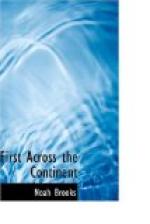On the third of July, accordingly, Captain Lewis, with nine of his men and five Indians, proceeded down the valley lying between the Rocky and the Bitter Root ranges of mountains, his general course being due northwest of Clark’s fork of the Columbia River. Crossing several small streams that make into this river, they finally reached and crossed the Missoula River from west to east, below the confluence of the St. Mary’s and Hell-gate rivers, or creeks; for these streams hardly deserve the name of rivers. The party camped for the night within a few miles of the site of the present city of Missoula, Montana. Here they were forced to part from their good friends and allies, the Indians, who had crossed the range with them. These men were afraid that they would be cut off by their foes, the Pahkees, and they wanted to find and join some band of the Indian nation with whom they were on terms of friendship. The journal gives this account of the parting:—
“We now smoked a farewell pipe with our estimable companions, who expressed every emotion of regret at parting with us; which they felt the more, because they did not conceal their fears of our being cut off by the Pahkees. We also gave them a shirt, a handkerchief, and a small quantity of ammunition. The meat which they received from us was dried and left at this place, as a store during the homeward journey. This circumstance confirms our belief that there is no route along Clark’s River to the Columbian plains so near or so good as that by which we came; for, though these people mean to go for several days’ journey down that river, to look for the Shalees (Ootlashoots), yet they intend returning home by the same pass of the mountains through which they have conducted us. This route is also used by all the nations whom we know west of the mountains who are in the habit of visiting the plains of the Missouri; while on the other side, all the war-paths of the Pahkees which fall into this valley of Clark’s River concentre at Traveller’s-rest, beyond which these people have never ventured to the west.”
During the next day or two, Captain Lewis kept on the same general course through a well-watered country, the ground gradually rising as he approached the base of the mountains. Tracks of Indians, supposed to be Pahkees, became more numerous and fresh. On the seventh of July, the little company went through the famous pass of the Rocky Mountains, now properly named for the leaders of the expedition. Here is the journal’s account of their finding the Lewis and Clark Pass:—
“At the distance of twelve miles we left the river, or rather the creek, and having for four miles crossed two ridges in a direction north fifteen degrees east, again struck to the right, proceeding through a narrow bottom covered with low willows and grass, and abundantly supplied with both deer and beaver. After travelling seven miles we reached the foot of a ridge, which we ascended in a direction north forty-five




